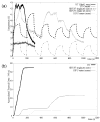Pulsed high intensity focused ultrasound mediated nanoparticle delivery: mechanisms and efficacy in murine muscle
- PMID: 19081668
- PMCID: PMC2668521
- DOI: 10.1016/j.ultrasmedbio.2008.09.021
Pulsed high intensity focused ultrasound mediated nanoparticle delivery: mechanisms and efficacy in murine muscle
Abstract
High intensity focused ultrasound (HIFU) is generally thought to interact with biological tissues in two ways: hyperthermia (heat) and acoustic cavitation. Pulsed mode HIFU has recently been demonstrated to increase the efficacy of a variety of drug therapies. Generally, it is presumed that the treatment acts to temporarily increase the permeability of the tissue to the therapeutic agent, however, the precise mechanism remains in dispute. In this article, we present evidence precluding hyperthermia as a principal mechanism for enhancing delivery, using a quantitative analysis of systemically administered fluorescent nanoparticles delivered to muscle in the calves of mice. Comparisons were carried out on the degree of enhancement between an equivalent heat treatment, delivered without ultrasound, and that of the pulsed-HIFU itself. In the murine calf muscle, Pulsed-HIFU treatment resulted in a significant increase in distribution of 200 nm particles (p < 0.016, n = 6), while the equivalent thermal dose showed no significant increase. Additional studies using this tissue/agent model also demonstrated that the pulsed HIFU enhancing effects persist for more than 24 h, which is longer than that of hyperthermia and acoustic cavitation, and offers the possibility of a novel third mechanism for mediating delivery.
Figures







References
-
- Clarke RL, ter Haar GR. Temperature rise recorded during lesion formation by high-intensity focused ultrasound. Ultrasound Med Biol. 1997;23:299–306. - PubMed
-
- Deng XC, Sieling F, Pan H, Cui J. Ultrasound-induced cell membrane porosity. Ultrasound Med Biol. 2004;30(4):519–526. - PubMed
-
- Dittmar KM, Xie J, Hunter F, Trimble C, Bur M, Frenkel V, Li KC. Pulsed high-intensity focused ultrasound enhances systemic administration of naked DNA in squamous cell carcinoma model: initial experience. Radiology. 2005;235(2):541–6. - PubMed
-
- Frenkel V, Kimmel E, Iger Y. Ultrasound-induced intercellular space widening in fish epidermis. Ultrasound Med Biol. 2000a;26:473–80. - PubMed
-
- Frenkel V, Kimmel E, Iger Y. Ultrasound-facilitated transport of silver chloride (AgCl) particles in fish skin. J Control Release. 2000b;68:251–61. - PubMed
Publication types
MeSH terms
Grants and funding
LinkOut - more resources
Full Text Sources

